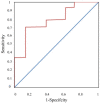Risk prediction of poor wound healing in patients with thoracoscopic lung cancer resection with drainage tube
- PMID: 38187071
- PMCID: PMC10767345
Risk prediction of poor wound healing in patients with thoracoscopic lung cancer resection with drainage tube
Abstract
This work established a risk prediction (RP) model for poor wound healing (PWH) in patients with thoracoscopic lung cancer (LC) resection (TLCR) after drainage tube placement to explore its application effect. 359 patients with TLCR were categorized into a good wound healing group (GWH group, 275 cases) and a poor wound healing group (PWH group, 84 cases) based on incision healing condition. The independent prediction risk factors (IPRFs) of PWH were analyzed and a RP model was constructed. 70% of the patients were classified as the model group (Mod group) and 30% were in the validation group (Val group). Resolution of the RP model was evaluated by the area under receiver operating characteristic (ROC) curve (AUC). The Hosmer-Lemeshow goodness of fit (HLGF) test was employed to evaluate the calibration of RP model. Results from the multivariate logistic regression analysis (MLRA) showed that age, preoperative albumin levels, diabetes history, dressing change frequency, and type of wound cleaning fluid were independent risk factors (IRFs) for postoperative PWH (P<0.05). In the Mod group, AUC=0.758 (P<0.05, 95% CI=0.712-0.806), and HLGF test showed P=0.493. In the Val group, AUC=0.783 (P<0.05, 95% CI=0.675-0.834), and HLGF test showed P=0.189. In conclusion, the constructed model was convenient, feasible, and demonstrates good predictive performance for postoperative incision healing issue, holding practical value and applicability.
Keywords: Lung cancer; poor wound healing; risk factors; risk prediction model; thoracoscopy.
AJCR Copyright © 2023.
Conflict of interest statement
None.
Figures
Similar articles
-
A prediction model of risk factors of poor wound healing after craniocerebral surgery.Pak J Med Sci. 2023 Nov-Dec;39(6):1835-1839. doi: 10.12669/pjms.39.6.7963. Pak J Med Sci. 2023. PMID: 37936752 Free PMC article.
-
[Establishment of a nomogram predicting risk factors of postoperative perineal wound complications after abdominoperineal resection for rectal cancer].Zhonghua Wei Chang Wai Ke Za Zhi. 2019 Apr 25;22(4):357-363. doi: 10.3760/cma.j.issn.1671-0274.2019.04.008. Zhonghua Wei Chang Wai Ke Za Zhi. 2019. PMID: 31054550 Chinese.
-
[Establishment and evaluation of early in-hospital death prediction model for patients with acute pancreatitis in intensive care unit].Zhonghua Wei Zhong Bing Ji Jiu Yi Xue. 2023 Aug;35(8):865-869. doi: 10.3760/cma.j.cn121430-20220713-00660. Zhonghua Wei Zhong Bing Ji Jiu Yi Xue. 2023. PMID: 37593868 Chinese.
-
[Risk factor analysis on anastomotic leakage after laparoscopic surgery in rectal cancer patient with neoadjuvant therapy and establishment of a nomogram prediction model].Zhonghua Wei Chang Wai Ke Za Zhi. 2019 Aug 25;22(8):748-754. doi: 10.3760/cma.j.issn.1671-0274.2019.08.009. Zhonghua Wei Chang Wai Ke Za Zhi. 2019. PMID: 31422613 Chinese.
-
[Construction of A Nomogram Prediction Model for PD-L1 Expression in Non-small Cell Lung Cancer Based on 18F-FDG PET/CT Metabolic Parameters].Zhongguo Fei Ai Za Zhi. 2023 Nov 20;26(11):833-842. doi: 10.3779/j.issn.1009-3419.2023.101.32. Zhongguo Fei Ai Za Zhi. 2023. PMID: 38061885 Free PMC article. Chinese.
References
-
- Lv D, He L, Guo L, Zhang X, He X. Acute kidney injury induced by immune checkpoint inhibitors in lung cancer patients. Discov Med. 2022;33:137–141. - PubMed
-
- Wang B, Zhang Z, Tang J, Tao H, Zhang Z. Correlation between SPARC, TGFβ1, endoglin and angiogenesis mechanism in lung cancer. J Biol Regul Homeost Agents. 2018;32:1525–1531. - PubMed
-
- Reck M, Remon J, Hellmann MD. First-line immunotherapy for non-small-cell lung cancer. J. Clin. Oncol. 2022;40:586–597. - PubMed
LinkOut - more resources
Full Text Sources


